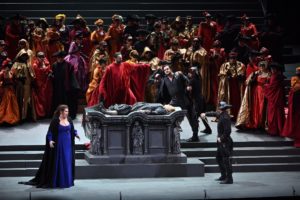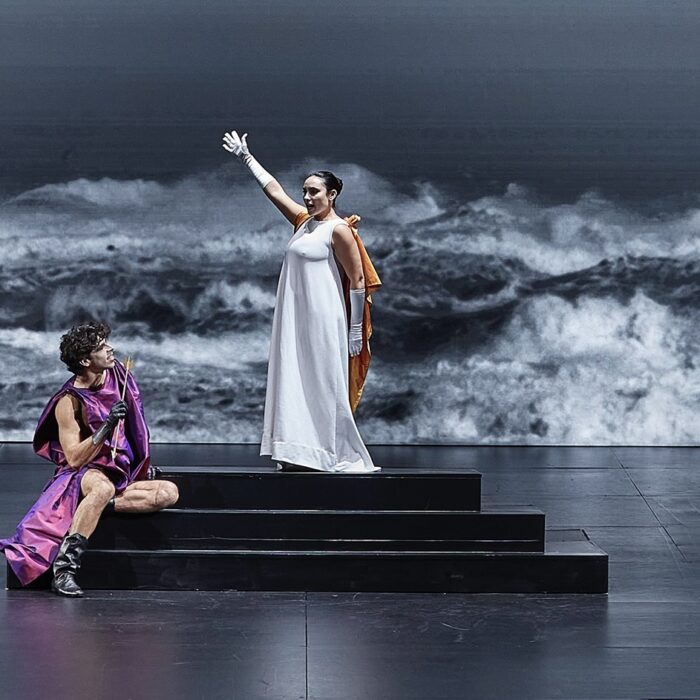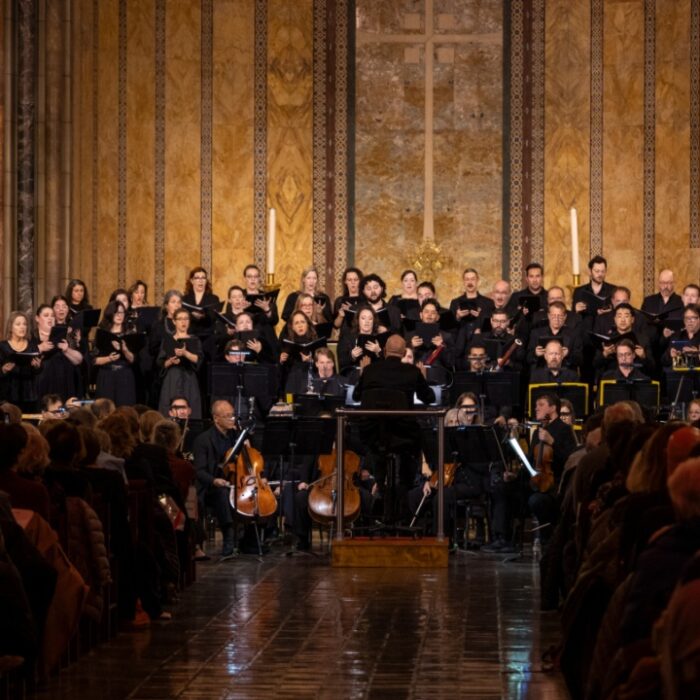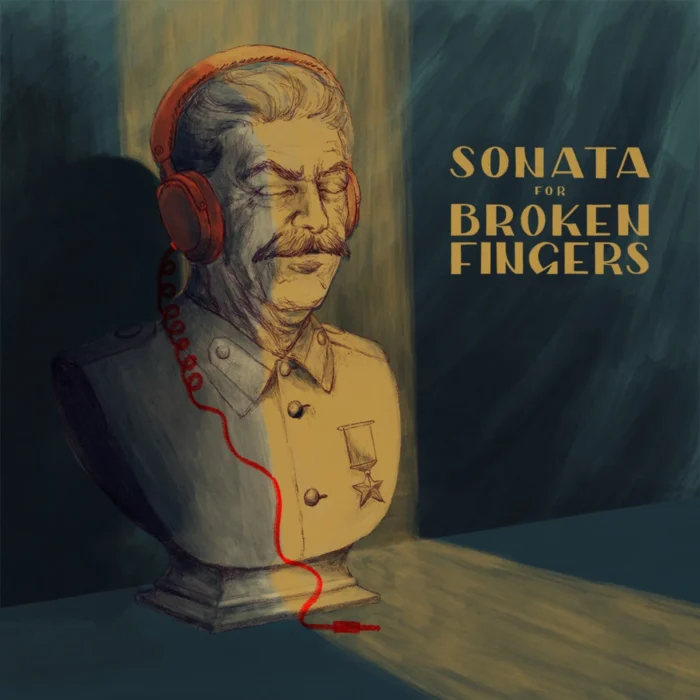
Gran Teatre del Liceu Barcelona 2018-19 Season Review: “La Gioconda”
Pretty Pizzi Production Provides Anna Pirozzi With Many Steps To Stardom
By Jonathan SutherlandWhen the the Gran Teatre del Liceu announced that legendary octogenarian Italian regista Pier Luigi Pizzi would be directing a new production of “La Gioconda” with Iréne Theorin making her title role debut, it was on paper at least, a must-see event. Unfortunately the parchment tended to perforate even before the prima when the celebrated Swedish diva canceled and second-cast soprano Anna Pirozzi stepped in to save Laura from her hostile hubby.
It’s Pretty, But Absurd
Unsurprisingly, Pizzi’s mis-en-scène and costumes were visually arresting, however other than some very realistic gondolas bobbing back and forth across the stage, the enormous precipitous steps which dominated the set could have been anywhere from Chonqing to Teotihuacán. Venice has around 300 bridges but none on such a gigantic scale. The Ponte di Rialto looks puny in comparison – or perhaps it was Pizzi’s idea of Gioconda’s stairway to heaven. Hopefully the endless Niesenbahn-inspired steps will work better when the production moves to the Arena di Verona. Certainly the iconic Venetian canoes were realistic, but their constant pitching and heaving was more like rounding Cape Horn in the Roaring 40’s than punting though the placid canals of La Serenissima. According to Dolora Zajick, they were also hell to get in and out of.
The acclaimed director would also have benefited from a quick visit to the Museo Storico Navale in Venezia. Square-rigged brigantines in the 17th century did not look anything like the dinky scarlet-hulled, stumpy-masted shallop which appears in Act two. Admittedly the ultimate immolation of the “Hecate” was extremely effective with lots of smoke, fiery falling spars and charred rigging. Its handsome bare-chested crew looked more like poster-boys for an Armani underwear billboard than traditionally undernourished Dalmatian swabbers.
Palazzo Badoero was closer to a campo grigio than Ca’ d’Oro and entirely al fresco. Laura didn’t get a boudoir, but her tomb in Act four would have rivaled Halicarnassus.
Pizzi’s lavish costumes seemed inspired by Stendhal’s “Le rouge et le noir” and were bordello sumptuous. Alvise’s enormous scarlet cloak with S&M black gloves made a striking image, especially when the long train fell the length of several steps during “Tutto la morte vendica.” Despite needing many bales of fabric, Laura’s deep blue taffeta gown with pearl choker in Act three was aptly “bella così” as Alvise observes. Curiously both diabolical Barnaba and good-guy Enzo were wearing basic black, although the latter was sporting more hipster Elvis leather couture. Enzo’s hair styling was closer to that of a 2019 gel-slicked boy-band leader than a 17th century shampoo-deprived seaman. Being bald, Barnaba did not have to worry about such modish coiffure concerns.
For a notorious public figure who had been banished from the Venetian Republic, it was remarkable that Enzo didn’t make any attempt to disguise himself whilst wandering around the piazza San Marco pretending to be an innocuous Dalmatian deckhand. He didn’t even bother to wear a mask of which the Venetians are so inordinately fond. This made Barnaba’s discovery of Enzo’s real identity not exactly an exemplar of Hercule Poirot perspicacity.
Typically with Pizzi, there was plenty to please the eye but dramaturgical insight and character development was less than La Cieca’s 20/1000 impairment.
Solidly Played, Though Hardly Inspiring
The complete ballet music was well-played and Gheorghe Iancu’s choreography was pleasing, albeit not particularly inspired. The famous “Dance of the Hours” was almost perfectly symmetrical in a June Taylor manner with some frisky Fonteyn-ish solos from Letizia Giuliani and Nureyev-like nimbleness from the remarkably blond Alessandro Riga.
The Orquesta Sinfónica del Gran Teatre del Liceu was led by Guillermo García Calvo who for the most part kept Ponchielli’s alternating pétillant and lyrical score on the move. There were several quirky tempi choices. La Cieca’s “A te questo rosario” and the “Deh! non turbare” duet were so sluggish it was as if the gondolas had run aground in the silt off Fusina. “Voce di donna” is marked andante sostenuto, not largo. In other sections, such as the Furlana, it was hectic hurdy-gurdy time.
Strings were frequently mellifluous such as the recapitulation of the rosario theme under Gioconda’s “come t’amo” fermata and even more so in the closing bars of Act one. The Preludio to Act four was taken more lento than andante and string attack needed more bite. Horns were generally accurate and pungent. Flutes were capriciously flirty during Barnaba’s taunting of Enzo in Act one.
The poignant cor anglais obbligato to “Figlia, che reggi il tremolo” was memorable but the oboe intervention in “Bella così, Madonna” slightly strident. Better solos came from first clarinet before Gioconda’s “O madre mia, nell’ isola fatale” and during the Act four Preludio.
The Coro del Gran Teatre del Liceu was committed but not always in strict tempo with the orchestra. “Feste e pane!” was already behind Calvo’s galloping beat and the tricky cross rhythms in “Lieta brigata” had serious synchronization problems. Admittedly the blood-thirsty rabble’s “A morte la strega” was appropriately frenzied, the “Ho! He! Ho!” sailors chorus salty and the “Già ti vedo” concertante section raised the resplendent roof of the Liceu. Unfortunately, overall diction was murkier than the Orfano canal.
Strong Voices
Looking like one of the more attractive novices in “The Sound of Music,” Maria José Montiel sang a stellar la Cieca. Visually, she could have been Gioconda’s sister rather than her madre adorata. Montiel has a impressive plumy, treacle timbre with killer chest notes. There were Marilyn Horne-ish hefty low A-naturals on “mi lega” and some extraordinary fermate such as the C-sharp on “figlia”, B-flat on “no” and an eternal F-natural on “ah” preceding “sulla tua testa” which could have been self indulgent if they weren’t so innately musical. “Voce di donna” and “A te questo rosario” were beautifully phrased with some sepulchral low C-sharps and B-flats.
Ildebrando D’Arcangelo has had a distinguished career as an A-list baritone for some years, but the lower tessitura of the role of Alvise seems now beyond his vocal comfort zone. The opening D-flat fermata on “Ribellion” was sufficiently effective to quell the seething witch-hunting rabble and “E salva sia” had a resonance reminiscent of Ruggero Raimondi but “Sì morir ella de!” revealed the singer’s vocal shortcomings. Although convincingly acted, there were too many problems in the low register with even B-naturals lacking projection.The low E-natural on “gemito” disappeared into the lagoon. There was a powerful F-natural fermata on “che muor” but it was a case of prima la recitazione, dopo la voce.
Ideally the role of Laura should be sung by a sexy young mezzo with deep chest notes commensurate with a pulchritudinous décolletage. Stefania Toczyska was the perfect example. Undeniably Dolora Zajick has the notes and the cleavage but at 67 could have been Enzo’s nonna. Singing the role for the first time, the American mezzo made up for matronly visual incongruousness with some really accomplished vocalism. Her opening “Grazie” with a knock-out E-natural fermata showed that Zajick can still pack a vocal punch. Low C-sharps on “pia” had meat and muscle. “Stella del marinar!” was effluvious but much more venerable than Vestal virgin. That said, there were delightful piano fermate on “ah” and “discenda”, some cavenous low C and even A-sharps and a gutsy A-natural on the final “benedizion” which occasioned vociferous bravas from Zajick’s eternally loyal Liceu fans.
Singing Instead of Snarling
Unlike many recent interpreters, Gabriele Viviani actually sang rather than snarled the role of the insidious priapic spy Barnaba. A character composite of Scarpia and Iago, there was plenty of Machiavellian menace in the opening “E mentre s’erge il ceppo” monologue making this sadistic snoop about as much fun as Reinhard Heydrich.
Viviani’s upper register is particularly strong and there were some solid high F-sharps such as the fermata on “Giuro all’Averno!” Curiously, the former bassoon player from Lucca chose to take the lower range option in “e penetro in fondo al tuo pensiero” which was ill-advised. Reclining smugly on the prominent centre-stage sarcophagus/altar, Barnaba’s great “O monumento!” scena which anticipates Iago’s “Credo in un Dio crudel” was the epitome of arrogant villany. The sinister parlando “la spia” would have won the Gestapo award for vocal intimidation. The fortissimo high F-naturals on “la Signoria più possente” had Raimondi-esque squillo and the top G-natural on “Parla” was splendidly focused.
“Pescator, affonda l’esca” was correctly con spirito with plenty of firm high F-naturals. The final C on “casherà” was held longer than stipulated but that was excusable artistic exuberance. Viviani was repugnant lust personified in the final “Ebbrezza! Delirio” duet and the top E’s and F natural on “Io l’ho affogata!” were as malevent as they were musically emphatic.
Since winning second prize in the 2012 Operalia, American tenor Brian Jagde has been making some important Europe debuts. The voice is reminiscent of Franco Bonisolli and a youthful, handsome stage presence doesn’t hurt either.
His opening extended fermata on “Assassini!” seemed to go on forever and had impressive squillo. “Gran Dio! la togli all’orrida” was boldly virile abetted by Calvo’s peppy tempo. The show-stopping “Cielo e mar” Romanza was preceded by a robust “buona notte” which characterized Jagde’s overall reading of the set piece. The indication is “con inspirata meditazione” not “pesante con fuoco.” Admittedly the first phrase is marked a piacere but Jagde’s fermata on the opening “Cielo” was so distended the cantilena was badly affected. The written dynamic is piano not forte. That said, the penultimate B-flat on “bacio” was rock solid but similar to many other celebrated Enzo’s such as Pavarotti and Corelli, the final sustained B-flat on “vien” ignored the correct crescendo-diminuendo marking in favor of a crowd-pleasing fortissimo fermata. With a slightly ligneous stage appearance, Jagde’s articulation and diction were often blurred, especially in the recitatives. There was also a tendency to smudge the attack and occasionally push in the upper tessitura such as “fanciulla santa.” Robusto sì. Raffinato no.
Hell of A Sing
Gioconda is one hell of a sing and at very short notice, Anna Pirozzi took over the prima. It was also a role debut. Although understandably nervous, from her tender “Madre adorata” it was clear the gifted Napolitana soprano was vocally a casa sua. Dramatically perhaps less so.
There was real metal in the four bar fortissimo top C on “madre” at the end of the “morte la stregha” cacophony. The top B-flat on “gioia” rode comfortably over the fortissimo orchestral tutti. The A-flat on “T’ho udito! menti!” and triplets on “L’onda del cor” were emphatic without losing intonation. Pirozzi has an impressive Caballé-esque floaty technique and the sustained gossamer top G-natural on “canta a Dio” and six beat B-flat fermata on “come t’amo” was beautifully pitched. No wonder Enzo exclaims “qual voce.”
“Tradita” and the final “B-flat on “Amor” at the end of the cat-fight duet with Laura had plenty of punch, while the low D and C natural chest notes on “o madre mi sorreggi” were round and fruity. There was an almost Verdian sweep to the long “Or più tremendo è il sacrifizio mio” phrase in Act three with exemplary breath control culminating in a strong top B-flat crescendo at “Ah, io la salva per lui.” Pirozzi was particularly impressive in the recitatives and the low D-naturals on “Fra brev’ora abbandono” had Gencer-like word coloring.
The great “Suicidio” aria is a serious challenge for any spinto, especially after hefty singing in the first three Acts. From the opening fortissimo F-sharp, it was clear that vocally Pirozzi was up to the task. The piano “E un dì leggiadre” passage was beautifully phrased with a fabulous floaty A-natural on “volovan.” The frequent octave leaps were precise and potent and low C-sharps on “fra le tenebre” and later “dentro l’avel” an example of optimal chest note singing. For good measure Pirozzi knocked off a stellar top C at the final “Addio.” There was lightness con eleganza on “Vo’ farmi più gaia” and the contemptuous “Volesti il mio corpo, demon maledetto?” could have been Maria Callas’ Tosca snarling at Tito Gobbi’s lascivious Scarpia. Pirozzi is not yet the anointed successor to La Divina but it was nevertheless an admirable performance.
When Theorin eventually sang a few performances, word on the Ramblas was that Pirozzi was far superior. Sometimes second-casts take First Prize. Brava Anna.


